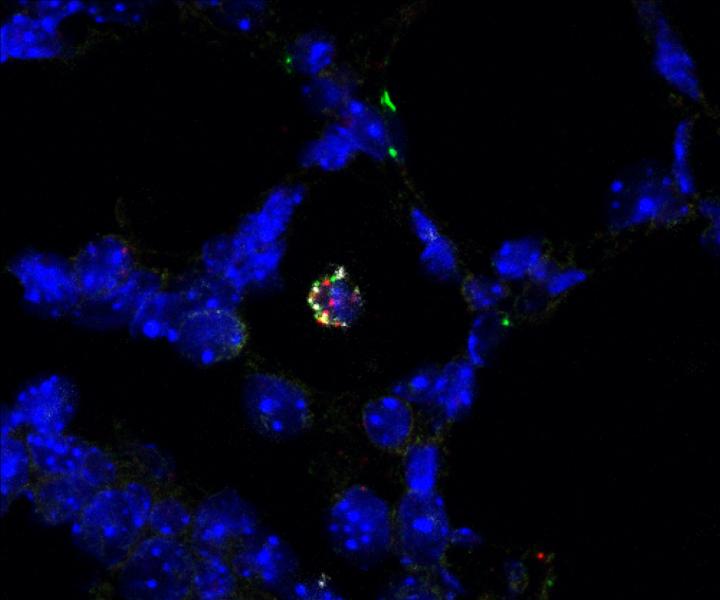A rapid increase in the number and types of immune cells in the lungs of mice after birth may aid development and help protect against infections

Credit: Domingo-Gonzalez et al. (CC BY 4.0)
An explosion in the number and types of immune cells in the lungs of newborn mice likely helps them adapt to breathing and protects them from infection, says a new study published today in eLife.
The findings, from Stanford University and Stanford School of Medicine, US, provide detailed information about dramatic shifts in the immune cells in the lungs of mice from just before birth through the first weeks of life. This insight may help scientists learn more about how problems in early development can lead to breathing problems such as asthma later in life.
“At birth, the lung undergoes marked physiological changes as it changes from a fluid-filled, low-oxygen environment to an air-filled, oxygen-rich environment,” says co-lead author Racquel Domingo-Gonzalez, who was a postdoctoral researcher at the Department of Pediatrics, Stanford University School of Medicine, when the study was carried out. “How these changes affect immune cell populations during this transition and the ensuing rapid lung growth after birth is unclear.”
To learn more, Domingo-Gonzalez and her collaborators used a technique called single-cell transcriptomics to track gene expression in individual immune cells in the lungs of mice just before birth and through the first three weeks of life. This allowed them to create an atlas of all the immune cells in the mouse lung during early life.
The team found that, just before birth, immune cells called macrophages encircle the small blood vessels in the lungs, likely stimulating them to grow. After birth, a large number of many different types of immune cells appear, including those needed for blood-vessel growth, lung development and to fight off infections.
These discoveries may help explain why disruptions to the immune system early in life caused by infections, excessive levels of oxygen, or steroid drugs may lead to life-long lung problems. “Injuries to the immature lung can have profound, life-long consequences since a significant component of lung development occurs during late pregnancy and the first few years of postnatal life,” explains co-lead author Fabio Zanini, who was a postdoctoral fellow in Stephen Quake’s lab at Stanford University when the study was initiated and has since transitioned to Senior Researcher at UNSW Sydney, Australia.
“Our work lays the foundation for further studies on the diversity of immune cells and their roles during this important window of lung development,” adds senior author Cristina Alvira, Associate Professor of Pediatrics at Stanford University School of Medicine. “This could ultimately lead to new therapies to preserve or enhance lung development in infants and young children.”
###
Reference
The paper ‘Diverse homeostatic and immunomodulatory roles of immune cells in the developing mouse lung at single cell resolution’ can freely accessed online at https:/
This study was a collaborative effort between Racquel Domingo-Gonzalez, Fabio Zanini and Cristina Alvira, as well as Stephen Quake – the Lee Otterson Professor of Bioengineering and Professor of Applied Physics at Stanford University, and Co-President of the Chan Zuckerberg Biohub – and David Cornfield, the Anne T. and Robert M. Bass Professor in Pediatric Pulmonary Medicine at Stanford University.
Media contact
Emily Packer, Senior Press Officer
eLife
[email protected]
01223 855373
About eLife
eLife is a non-profit organisation created by funders and led by researchers. Our mission is to accelerate discovery by operating a platform for research communication that encourages and recognises the most responsible behaviours. We work across three major areas: publishing, technology and research culture. We aim to publish work of the highest standards and importance in all areas of biology and medicine, including Developmental Biology, and Immunology and Inflammation, while exploring creative new ways to improve how research is assessed and published. We also invest in open-source technology innovation to modernise the infrastructure for science publishing and improve online tools for sharing, using and interacting with new results. eLife receives financial support and strategic guidance from the Howard Hughes Medical Institute, the Knut and Alice Wallenberg Foundation, the Max Planck Society and Wellcome. Learn more at https:/
To read the latest Developmental Biology research published in eLife, visit https:/
And for the latest in Immunology and Inflammation, see https:/
Media Contact
Emily Packer
[email protected]
Original Source
https:/
Related Journal Article
http://dx.




